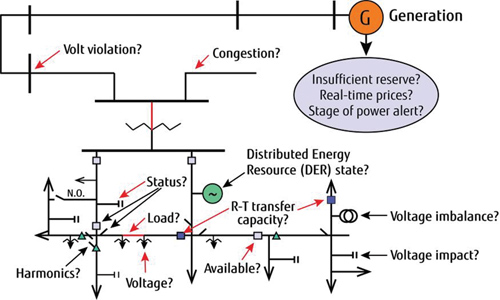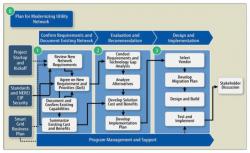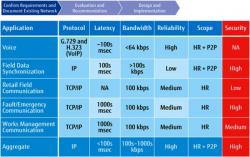Utilities’ transmission and distribution professionals and their peers in information technology organizations are faced with numerous challenges in today’s environment. End customers and regulators want a more efficient and reliable grid; the current grid assets are aging; and new demands including: higher plug loads, distributed generation, electric vehicle integration and challenging environmental conditions are being placed on the existing grid’s automation systems. Utilities must pursue grid modernization, including implementing automation solutions, for reliability and to meet these growing demands. This must be done while at the same time extending the life of existing grid assets and with little to no increase in operating budgets. This is no small task.
The challenge, and the opportunity, can best be described in terms of assets that need to be evaluated, followed by development of a plan utilizing advanced sensor technology and communications systems. The result can be an information-rich grid that generates positive returns on investment in terms of operating costs, power delivery efficiency, and grid reliability.
Grid automation plays a vital role in that these systems make it possible to isolate a fault and reconfigure a distribution system without requiring manual switching. With advanced distribution automation, a utility can isolate a fault and reconfigure a distribution system in a short time period (typically less than two minutes) without human intervention. Due in large part to advances in automation technology over the last decade, including enhancements in relays, reclosers, communications systems, and software, utilities can make step-function improvements in reliability at appropriate times and with a reasonable cost.
To get a feel for just how effective automation is, consider that in a well-maintained distribution system with no automation, the average customer experiences 120 minutes of outage each year. Worse yet, the further a customer is from an available energy source, the longer it takes to restore service, resulting in significantly different levels of reliability based on location. The following diagram illustrates the distribution grid with key automation information requirements.

Communication systems are put in place to capture and relay data points to the control center.
This information will help identify problem areas for faster resolution.
By employing distribution automation then, a utility can cost-effectively reduce outage time and improve response. The series of steps described below assume that a utility is in its initial stage of approaching distribution automation as a means to improve system reliability. It also illustrates the design concept required to achieve varying levels of system reliability over a period of time.
Measurable Benefits
Advanced information technology, databases, communication and controls are increasingly making a vast array of new grid distribution applications possible. To the extent they are economic and/or promote other policy goals, utilities have the ability to build these technologies into their distribution systems and transform their grid, achieving advances in:
- Reliability: With higher-quality delivery, less-frequent outages, and dramatically faster restoration when an outage does occur
- Security: By increasing the use of distributed generation as a part of total generation
- Economics: With optimal peak and average energy prices set by region; losses due to power transmission congestion, interruptions or quality degradation minimized; resulting in a lower overall total cost of energy delivered
- Efficiency: Occurs through a lower level of system electrical losses, a lower peak-to-average load ratio and lower number (< 10 percent) of lines congested for a duration of time
- Environmental stewardship: Achieving a higher ratio of renewable generation to total generation and reducing emissions per kilowatt-hour delivered
- Safety: Significant reduction in injuries and deaths to workers and the general public
Having described these benefits, it’s also important to keep in mind that different types of distribution networks/systems (e.g. urban, suburban, rural, special use) have different characteristics and each will return more or less benefit through automation. Said another way, automation applications that provide positive value in one part of the overall system may not be applicable to, or deliver positive economics in, other parts of the system. Given that, it’s wise to work with a partner that understands these differences and can offer appropriate guidance.
Energy and Information Flows
Traditional grids were designed to perform one function – distribute electrical energy to end-users. But increasingly, distribution systems are delivering electrical energy and information between participants, system operators, and system components. As implementations of demand response and other Distributed Energy Resources (DER) applications find their way into grid architectures, we see the lines between electricity supplier and consumer blur; many of the participants will actually assume both roles. In this scenario, the exchange of information is multi-directional and will facilitate smarter system operations, and potentially enable decisions on whether to act as a ‘supplier’ or ‘user’ of electrical energy based on dynamic (rather than static) pricing.
For this sophisticated exchange of electricity and information to be possible, the automated grid relies on a communications architecture that supports network component monitoring and system control functionality. Ideally, these communications architectures will be designed on open systems so that new technologies and components from multiple vendors can be easily integrated as required. The automated grid also relies on new electrical architectures and protection systems that enable an interoperable network of components.
Taken together, the communications architecture, protection systems and interoperable components comprise the automated distribution system at the heart of grid transformation.
The Information/Communications Infrastructure
In a grid transformation, the link between customers, smart devices on the grid, and system operators lies in the communications infrastructure. As the complexity of these communications grows and the time-frame tolerated for information exchange decreases, the infrastructure must provide a higher-bandwidth and lower-latency. Also, as more critical functions are automated, the communications infrastructure must provide a heightened-level of security. And just as is true when defining the optimum energy infrastructure, the right communications infrastructure will be built on an open architecture and common protocols, enabling the interoperability of different devices from different vendors.
It is the communications infrastructure that enables many of the features grabbing headlines in the general media. Capabilities such as Advanced Metering Infrastructures (AMIs) catch the attention of the end-user. Sensing and monitoring devices, as well as intelligent applications, transmit valuable usage and management/control information that is viewable through secure consumer portals.
For the utility, a grid transformation delivers the same advantages as are enjoyed by the end-user, and then some. The utility will gain real-time state estimation and predictive capabilities (including fault simulation modeling). With this, it becomes possible to continuously assess the overall state of the distribution system and predict future conditions, providing the basis for system optimization. Advanced control systems allow the utility to optimize performance of the entire distribution system for efficiency, asset management, reliability, quality, and security. And last but certainly not least, load management and real-time pricing becomes a reality which allows the utility to optimize system performance, efficiency and profitability.
Getting There
While each individual utility that is considering a grid transformation project will have its own set of priorities, challenges and business dynamics, there are a few considerations that are universal to all. The design and development of any distributed automation communications architecture must consider:
- Scalability
- Reliability
- Federation
- Interoperability
- Adaptability
- Security
Scalability should be looked at through a long-range lens. For some utilities this will mean projecting-out five, ten or even more years. In so doing, it’s important to consider what the future might hold across multiple variables. For example, look at population growth rates, review the applications that may require additional support and think about how many physical sites could be added to the network.
Reliability is nearly taken for granted by the general public. Of course utility professionals know better. Ensuring reliability means using robust technology with a proven ability to deal with failure gracefully. Any part of a distributed system can fail. Any grid transformation communications architecture must incorporate backup components and the ability to execute a seamless failover.
Federation is a particularly important idea in many grid transformation projects because multiple vendors’ technologies are involved. When working for the benefit of the end-user customer, the vendors involved in the transformation will often agree as a group to support a set of standards. This federation greatly simplifies interfacing between end-user communication and control systems.
Interoperability is of course the goal of communications standards in general. However, when it comes to grid transformations, the sheer scope and variety of technologies in use places particular challenges on those responsible for making architectural decisions.
Adaptability also takes on a new importance in grid transformations. In contrast to traditional energy networks, where adaptation is almost always a manual, labor-intensive (and capital-intensive) process, successful grid transformations are those architected to adapt quickly and automatically, with as little human intervention as possible.
And last, but far from least in our list of important considerations, security. In a grid transformation, technology must be selected to support secure communications, safe from attack from within or outside a utility. A grid transformation presents unique security challenges. This is because distributed automation requires the integration of communications technologies across previously siloed (and firewalled) groups. Integration frequently occurs between SCADA and protection departments, automation departments into corporate IT domains and entire utilities into a deregulated market. With each level of integration comes the possibility of creating vulnerability in the network. Communications technologies that have proven to be most secure should be selected to minimize any security risks.
A Proven Methodology
Your partner in any grid transformation project should be one that’s lived the experience on multiple occasions. Make sure there is a proven, repeatable methodology leading to a track record of success. Unfortunately, there is not enough space in one article to describe in detail the methodology I recommend, or the individual tasks and sub-tasks therein. However, the illustration below offers an overview, and I will summarize the major tasks that make-up this methodology.

A proven methodology results in a coordinated effort that provides both the
necessary breadth and depth of analysis, alternative development and recommendations.
A Three-Step Approach
A successful grid transformation begins with a structured, logical progression of steps to devise a grid modernization plan. The three steps in this progression are broadly defined as:
- Confirm Requirements and Document Existing Network
- Evaluation and Recommendation
- Design and Implementation
This structure will result in an objective, unbiased communications plan that utility management can use to support the need for modernization and integration of their communications capabilities. This plan is put into action with a methodology that lays-out a ‘Road Map’ of five task groups leading to a successful conclusion.
Let’s talk about the first three of the five task groups. The first three tasks fall within what I call the project’s discovery phase. The project team will conduct a kick-off meeting to ensure everyone understands the expected deliverables, players’ roles and project schedule. After the kick-off meeting, there will be an assessment of current demand, utilization and future needs; followed by an assessment of the current infrastructure. The team will also conduct a legal and regulatory assessment. This is intended to yield a keen understanding of all such requirements (including licensing requirements) that need to be addressed in the implementation of the future network and services. The key outcome of these efforts will be the design of a network architecture that allows the communications network to accommodate all current and foreseeable needs with reliability, scalability and flexibility.
One of the initial tasks is to assess the network requirements for each communications application, e.g. voice, field data synchronization, retail field communications and others (see application types listed in leftmost column of chart shown at the top of the next page). It is important to understand these requirements to ensure sufficient bandwidth is allocated across the enterprise. In traditional network environments each application exists in a silo, with bandwidth allocated to each independently. But a grid transformation changes that approach. In a grid transformation, these applications will interact across the enterprise; therefore, there must be adequate bandwidth enterprise-wide.

Determining the total communications requirements for
Grid Automation is part of the project discovery phase.
At the conclusion of the discovery phase, the project team will conduct a gap analysis between the existing network and the new required communications infrastructure.
Based on the findings, the team will progress to Task 4. This task focuses on identification of alternative technologies available in the marketplace, and determination of the right technologies to meet current and future needs. The team will present to management a number of communications networking implementation options with associated schedules and costs.
The final task, Task 5, focuses on development and presentation of the detailed telecom strategy by the project team. The presentation should include:
- Summaries of the processes used and issues considered to develop the recommendation
- A strategic telecommunications plan for utilities consisting of:
- Ultimate system plan in detailed block diagram format
- Cost estimate to implement strategy
- Recommended migration plan to new system
- Discussion of recommended plan’s compliance with utilities’ business initiatives
- Analysis of existing voice communications strategies, their fit with the recommended telecom strategy, and any recommended modifications
- Estimates of manpower and equipment requirements to install operate and maintain the proposed solution, including training, test equipment, software, etc.
- Brief synopsis of alternate strategies/solutions considered
- A high level strategic plan or ‘Road Map’ that brings together the transport, mobile, voice, and wireless data strategies under an overall strategy, describing any synergies and/or conflicts they may have.
Conclusion
The utilities industry is in the early stages of what will be a pronounced evolution. Consumer demand, changing energy usage patterns and the availability of advanced technologies are driving grid transformations. By using secure, non-proprietary, automated-healing technologies as the basis for these transformations, utilities are meeting current requirements while being equipped to meet changing needs in the future. But beyond the characteristics of the individual technologies, I believe having a proven methodology is critical. Taking a methodical approach to the transformation gives utilities maximum flexibility and control in how they proceed and is shown to result in the highest levels of success.
About the author
 John Chowdhury is utility practice director at Fujitsu Network Communications, Inc. He develops unique network integration solutions, modernization programs and network operations offerings tailored to support utilities as they adapt their communications networks to meet new demands for scalability, reliability, standards, and security.
John Chowdhury is utility practice director at Fujitsu Network Communications, Inc. He develops unique network integration solutions, modernization programs and network operations offerings tailored to support utilities as they adapt their communications networks to meet new demands for scalability, reliability, standards, and security.
Recognized as a ‘Who’s Who in Energy’ by the Dallas Business Journal, John has dedicated his 25-year consulting career to improving electric utility and telecom business performance. He has provided strategic business and technology guidance to international energy entities in the areas of: Smart Grid/AMI/distribution automation; business case development; customer relationship management; billing; and telecommunications/wireless networks.








